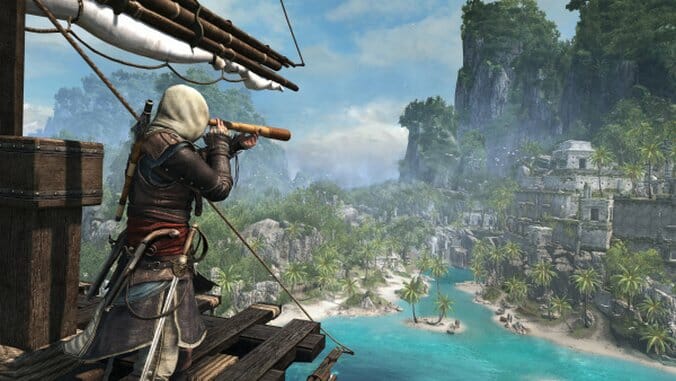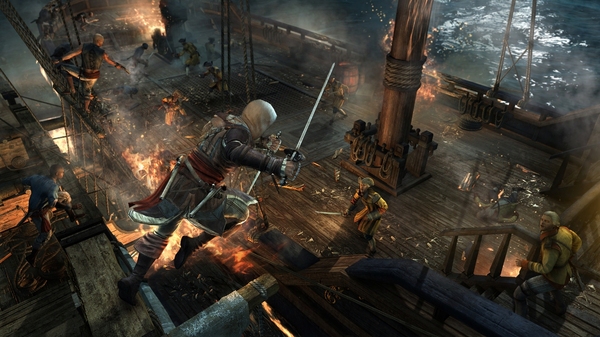Assassin’s Creed IV: Black Flag (Multi-Platform)

The best part of Assassin’s Creed IV: Black Flag comes whenever you add a new ship to your fleet. It prompts a canned animation where your pirate captain Edward Kenway puts a big hat on one of his crewmembers, who gets a dopey grin on his face as he realizes what’s happening. He turns around and a second crewmember excitedly shakes his arms with a look of complete euphoria , like the friend in an ad where a teenager gets his first car. Like Assassin’s Creed IV itself, it’s awkward and endearing and unabashedly corny. That one brief, recurring cut-scene summarizes the entire series.
How does a game that’s always wrapped up in a dull post-modern framing sequence about a guy playing a game remain so un-self-aware? Like its predecessors Assassin’s Creed IV is unflinchingly sincere, devoted to the paranoid style of history and a convoluted metastory about a modern day company pillaging the memories of assassins to find artifacts left by ancient alien astronauts. The closest Assassin’s Creed has ever come to self-awareness was when the witty playboy Ezio Auditore da Firenze smirked his way through the Renaissance in Assassin’s Creed II and its spin-offs.
That po-faced spirit is what makes these games likable, though, and Assassin’s Creed IV is delightfully earnest. It takes itself very seriously without ever devolving into tired grimness or cynicism. At its best it captures the tone of the Flynn-de Havilland classic Captain Blood and other old Hollywood swashbucklers, presenting light-hearted adventure without any winking irony. Unsurprisingly, this happens almost entirely in the scenes set in the 1700s, which fortunately make up the overwhelming majority of the game.
Yes, Assassin’s Creed IV is about pirates. It takes one of the best parts of Assassin’s Creed III, the brief bits of naval combat, and builds an entire game around them. You travel largely by boat, like a Wind Waker with blood on its mind, picking off easy targets from the British or Spanish fleets while sailing from one storyline mission to the next. In combat you flank the other ships and pepper them with cannons, or target weak spots on the hull with swivel guns. After cutting through its defenses and boarding your rival, your crew of rabble-rousing free men has to kill a certain number of sailors in traditional Assassin’s Creed hand-to-hand combat in order to make off with the rum and sugar in the hold. Survivors can be liberated into serving under your flag, whereas the remnants of their boat can either repair your ship or be added to your growing pirate fleet. As your crew grows and your ship becomes stronger you can take on larger and more powerful boats for greater prizes. It’s like the water battles in Assassin’s Creed III but deeper, more frequent and with greater customization of your ship.
The lure of the sea doesn’t completely steal you from your duties ashore. Much of the game, and most crucial storyline moments, take place on land, from bustling Caribbean cities like Havana to uncharted islets dotted with nothing more than a shack and a few trees. Here you can run and climb as easily as Ezio clambered up St. Mark’s Basilica. It’s the same fluid free motion that Assassin’s Creed has always excelled at, replete with the swift assassinations, counter-based swordplay and stealthy shenanigans you’ve grown accustomed to.
Assassin’s Creed games get the most out of their open world design by dropping us in enthralling real-world settings with a generous freedom of motion. The free motion in Prototype and Saints Row IV fits the superpowered theme of those games, where you can just literally run up the side of a building and leap into the sky and soar for miles. But it also undermines the worlds you’re running in—they’re so divorced from the laws of physics that it becomes hard to view the world as anything other than a faceless toy box to rummage through. On the other end is GTA, where buildings are mostly set dressing that you can’t do anything with. Assassin’s Creed IV constructs this beautifully designed game world and then lets you scamper all over it, turning architecture into the most vital part of the game. It’s one of the few open world games where the buildings that make up that world actually seem to matter, even if you still mostly can’t go inside them.
